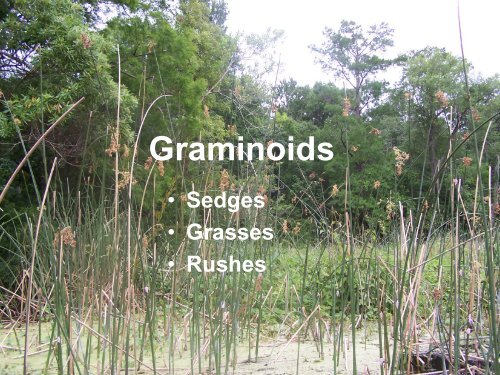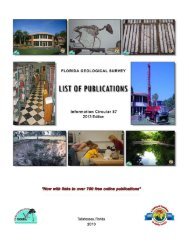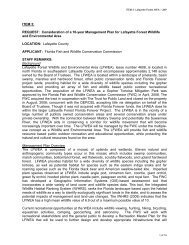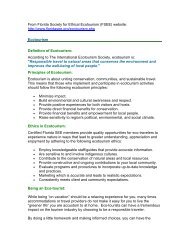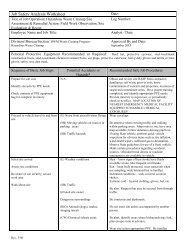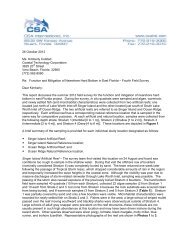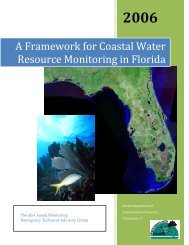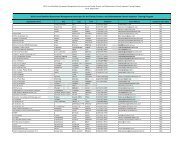Graminoids: Sedges, Grasses, Rushes
Graminoids: Sedges, Grasses, Rushes
Graminoids: Sedges, Grasses, Rushes
You also want an ePaper? Increase the reach of your titles
YUMPU automatically turns print PDFs into web optimized ePapers that Google loves.
<strong>Graminoids</strong><br />
• <strong>Sedges</strong><br />
• <strong>Grasses</strong><br />
• <strong>Rushes</strong>
<strong>Graminoids</strong><br />
“<strong>Sedges</strong> have edges,<br />
<strong>Rushes</strong> are round, and<br />
<strong>Grasses</strong> have nodes where<br />
leaves are found”<br />
…usually.
Cyperaceae<br />
(<strong>Sedges</strong>)<br />
Stems usually 3-angled<br />
(or round, 4-angled,<br />
lenticular)<br />
Stems usually with solid<br />
pith<br />
Poaceae<br />
(<strong>Grasses</strong>)<br />
Juncaceae<br />
(<strong>Rushes</strong>)<br />
Stems round (terete) Stems round (terete)<br />
Stems with solid nodes<br />
and hollow internodes<br />
Stems with solid pith<br />
Leaf sheaths closed Leaf sheaths open Leaf sheaths open<br />
Leaves 3-ranked or<br />
spiral<br />
Fruit an achene with<br />
bristles, bracts, may<br />
have tubercle<br />
Leaves 2-ranked Leaves 2-ranked<br />
Fruit a grain with papery<br />
palea, lemma, and<br />
glumes<br />
Fruit a capsule with tiny<br />
dust-like seeds
<strong>Sedges</strong>
Common Sedge Genera<br />
• Cyperus - flat sedges<br />
• Rhynchospora (Dichromena, Psilocarya) –<br />
beakrushes<br />
• Eleocharis – spikerushes<br />
• Scirpus - bulrushes<br />
• Fuirena<br />
• Carex<br />
• Cladium (sawgrass), Scleria (nut rushes),<br />
Dulichium (three-way sedge), Fimristylis,<br />
Bulbostylis, Websteria
Cyperus<br />
• 2-ranked floral scales on spikelets<br />
• Basal leaves (articulatus, haspan,<br />
involucratus don’t really have)<br />
• Leafy bracts subtend inflorescence<br />
• Key characters - # stigmas (2 or 3),<br />
shape of achene (lenticular or<br />
trigonous), how achenes separate from<br />
spikelet<br />
Stigma 2-parted<br />
Lens-shaped achene<br />
Cyperus polystachyos<br />
Cyperus lecontei<br />
Cyperus odoratus<br />
Cyperus erythrorhyzos<br />
3-sided achene
Cyperus involucratus<br />
Umbrella Plant<br />
• Invasive exotic<br />
• Formerly C. alternifolius<br />
• Very large bracts subtending inflorescence<br />
• No basal leaves
Cyperus articulatus Scirpus validus<br />
•Cross partitions in<br />
stems
C. haspan<br />
• soft triangular stem<br />
• minor basal leaves<br />
• fruits shed from the<br />
base of spikelet while<br />
tops still flowering
Cyperus erythrorhyzos<br />
• Many spikelets on inflorescence axis<br />
• 3-sided fruit<br />
• Fruits fall off spikelet axis<br />
spikelet<br />
Achene (fruit)
Cyperus odoratus<br />
Fruits disarticulate
Cyperus surinamensis Scirpus cubensis
Rhynchospora<br />
(Beaksedges)<br />
• Tubercle on achene<br />
• Plants leafy<br />
• Key characters –<br />
– perianth bristles (length,<br />
barbs)<br />
– Tubercle (length, shape)<br />
– arrangement of spikelets<br />
(clusters or spreading)
Rhynchospora inundata and corniculata<br />
Perianth bristles > achene body Perianth bristles < achene body
Rhynchospora tracyi<br />
• Long tubercle,<br />
spikelets in clusters<br />
• Leaves rolled
Rhynchospora microcephala
Rhynchospora (Psilocarya) nitens<br />
Small black spikelets, jointed appearance
Rhynchospora Juncus<br />
Look at stems, fruits
Eleocharis spp.<br />
Spikerushes<br />
• Leafless stems in clumps<br />
• Single terminal spike of fruits<br />
• Sprout from stem tip<br />
• Key characters –<br />
– Stem shape (flat, round, triangular, square)<br />
– Spikelet size and shape (wider than stem or not)<br />
– Perianth bristles<br />
– Tubercle<br />
– Achene surface ornamentation<br />
E. interstincta
E. cellulosa, equisitoides, interstincta all are large<br />
species with the spike same width as stem<br />
E. equisitoides<br />
and E. interstincta<br />
have nodoseseptate<br />
stems
Eleocharis<br />
equisitoides vs.<br />
interstincta<br />
Larger achene, shorter bristles Smaller achene, longer bristles<br />
Partitions crowded<br />
near spike<br />
E. equisitoides E. interstincta
S. californicus<br />
Scirpus<br />
(Bulrushes)<br />
• Tall leafless stems (usually)<br />
• Bract extending beyond<br />
inflorescence, no leafy<br />
subtending bracts<br />
• Round or triangular stems<br />
• Fruit an achene without<br />
tubercle, with bristles<br />
S. cyperinus
Scirpus (triangular stems)<br />
• Triangular stems – S. americanus, S. pungens, S. robustus (marine)
Scirpus (round stems)<br />
• S. californicus – no leaves, bristles red, feathery, harder and taller stem<br />
• S. tabernaemontani – no leaves, bristles white, barbed, stem softer & shorter<br />
• S. cyperinus – longer and bushier fruiting head, leaves along stem<br />
Name Changes:<br />
Schoenoplectus (no leaves on<br />
stems) – S. californicus, S.<br />
tabernaemontani, S. pungens, S.<br />
americanus, S. robustus<br />
Scirpus – S. cyperinus
Scirpus cubensis<br />
(Oxycaryum cubense)<br />
• Leafy/invasive exotic<br />
• Does not look like all other Scirpus species<br />
• Now in genus Oxycaryum
Fuirena (umbrella sedges)<br />
Mostly small plants, 20-50 cm tall<br />
F. squarrosa, breviseta, and pumila look alike
Fuirena scirpoidea<br />
rush fuirena<br />
• Round stems without leaves<br />
• 1-3 (usually) seed heads<br />
• Distinct triangular leaf<br />
sheaths at nodes along stem<br />
• Height to 1 m in standing<br />
water<br />
• Dark green above water<br />
surface, light green below
Carex<br />
• Huge genus, generally not aquatic<br />
• Male and female inflorescences often separate on same<br />
stem<br />
• Fruit enclosed in a sac
Carex lupulina<br />
• Streamsides<br />
• Note sacs
Carex<br />
albolutescens<br />
• Looks a little like<br />
Fuirena<br />
• Carex fruit in sac,<br />
Fuirena fruit<br />
surrounded by papery<br />
bracts
Cladium jamaicense<br />
•1-3 meters tall<br />
•Grayish-green color<br />
•Scabrid leaf margins and midrib
Scleria (nutrushes) • “golf ball” fruits<br />
• flattened triangular<br />
stem at leaf bases
Dulichium arundinaceum<br />
• 3-ranked leaves
Websteria confervoides<br />
• Submersed, clumps of stems on long stolon<br />
•“Puffballs”
<strong>Grasses</strong><br />
• Ligule<br />
•Pith<br />
• Sheath<br />
• Fruits
Common <strong>Grasses</strong><br />
in lake or fringe<br />
• Submersed/Floating • Emergent – High<br />
– Luziola fluitans<br />
– Echinochloa spp.<br />
• Emergent – Low<br />
– Saccharum (Erianthus)<br />
– Leersia hexandra<br />
giganteus<br />
– Panicum repens<br />
– Phragmites australis<br />
– Paspalum repens<br />
– Zizania aquatica<br />
– Zizaniopsis<br />
• Emergent - Mid<br />
– Panicum hemitomon<br />
– Sacciolepis striata<br />
– Urochloa (Brachiaria) mutica<br />
– Hymenachne amplexicaulis<br />
– Paspalidium geminatum
Luziola fluitans – Water Grass<br />
• Slender grass growing in shallow water<br />
• Leaves float
Paspalum<br />
repens<br />
•Fruits on “leaves” (winged rachis)<br />
•Sprawling and floating<br />
•Purple spots on sheaths<br />
•Stems spongy, roots dark
• Forms mats on water surface<br />
• Even leaf heights, “hair cut”<br />
grass<br />
• “stiffly ascending leaves < 9<br />
mm wide”<br />
• Leaf blades scabrous<br />
• Fruits flattened, peach-colored<br />
Leersia hexandra<br />
Southern Cut Grass
Panicum repens - Torpedograss<br />
• Floating mats<br />
• Bluish-green color<br />
• Flowers purple and orange<br />
• Rhizome tip pointed and white<br />
(torpedo-like)<br />
• Sits fairly low to the water, but not<br />
regular like Leersia
Panicum<br />
hemitomon<br />
Maidencane<br />
• Flowers/fruits appressed to stem<br />
• Stems and nodes sometimes hairy<br />
• Can create large stands of varying thickness<br />
• Plants come higher out of the water than P. repens<br />
• Ligule of long hairs, more obvious than in<br />
Sacciolepis striata
• Can form dense<br />
stands<br />
• Conspicuous<br />
nerves on leaves<br />
• Short hairs on<br />
sheath<br />
• Short ligule<br />
• Spikelets not<br />
close against<br />
central axis of<br />
inflorescence<br />
Sacciolepis striata<br />
American cupscale
Urochloa (Brachiaria) mutica<br />
• Sprawling, medium-height, matforming<br />
grass<br />
• Swollen nodes with dense hairs<br />
• Sheaths loose, overlapping<br />
• Inflorescence and open<br />
panicle, 8-20 alternate<br />
branches<br />
• Spikelets purplish<br />
Pará grass
• 1-2.5 m high<br />
Hymenachne amplexicaulis<br />
West Indian Marsh Grass<br />
• Perennial, stoloniferous<br />
• Leaf blades up to 4 cm wide,<br />
cordate at the base<br />
• Stems glabrous, white pith<br />
• Panicles narrow, pressed against<br />
axis, July on
Paspalidium geminatum<br />
• Sheaths longer than internodes<br />
• Leaf blades can be involute or folded<br />
• Tufted stems, long leaves<br />
• Seeds on one side of rachis<br />
• Ligule a fringe of short hairs
Echinochloa<br />
walteri and crus-galli<br />
• No ligule<br />
• Long awns<br />
• E. walteri has 2 awns/spikelet, E. crusgalli has 1<br />
• Edges of leaves scabrous, hairs on edges of sheath
Echinochloa crusgalli<br />
Barnyard Grass
Saccharum giganteum<br />
Sugarcane plumegrass<br />
• Common grass, often in<br />
roadside ditches<br />
• Large silky inflorescence<br />
• Not very leafy<br />
• Formerly Erianthus<br />
giganteus
Saccharum (Erianthus) giganteus<br />
Sugarcane Plumegrass<br />
Big <strong>Grasses</strong><br />
Andropogon glomeratus<br />
Bushy Broom Grass<br />
Echinochloa wateri<br />
Coast Cockspur-grass
• Large grass of fresh<br />
and brackish water<br />
• Large silky<br />
inflorescence<br />
• Leaves alternate<br />
along stem<br />
• Fringe-like ligule of<br />
short bristles<br />
Phragmites australis<br />
Common reed
Zizania aquatica<br />
Wild rice<br />
• Large clumping grass, often<br />
in flowing waters<br />
• Basal leaves<br />
• Male and female separate<br />
on inflorescence<br />
• Stem of inflorescence round<br />
and spongy
Zizaniopsis miliacea<br />
Giant cutgrass<br />
• Large clumping grass,<br />
usually in quiet waters<br />
• Basal leaves<br />
• Leaves smooth on<br />
surfaces, sharp<br />
margins<br />
• Large inflorescence,<br />
all drooping<br />
• Base of inflorescence<br />
stem flat
Juncus spp. (<strong>Rushes</strong>)<br />
• Stems round, with or<br />
without leaves<br />
• Fruit a capsule full of tiny<br />
seeds<br />
Key characters-<br />
• Capsule shape, size<br />
• Long or short bract<br />
subtending inflorescence<br />
• Flowers/fruits single or in<br />
clusters<br />
• Presence or absence of<br />
cross-partitions in stems (see<br />
or feel)<br />
• Leaf blades flat or round
Juncus roemerianus<br />
• Estuarine or tidal habitats<br />
• Bract goes past inflorescence<br />
• Stems up to 1.5 m tall, grayish-green
Juncus effusus<br />
– Large common freshwater species<br />
–Clumping<br />
– Large bract that looks like continuation of stem
Juncus effusus
• Juncus repens<br />
– equitant flattened leaves<br />
– sprouting new individuals from<br />
stem ends<br />
– submersed or stranded
• Fruits arranged in loose clusters<br />
• Stems somewhat flattened<br />
• Plant to 1 m tall<br />
• Fruits rounded with blunt tips
Juncus megacephalus<br />
• Cross-partitions<br />
• Rounded leaf blades<br />
• Capsule long and pointed<br />
with purplish tip
Thank you<br />
Questions?
Dichanthelium<br />
vs. Panicum<br />
• Until recently, Dichanthelium was a<br />
genus within Panicum<br />
• Most species of Dichanthelium have<br />
short shoots from leaf axes (spring<br />
and summer)


